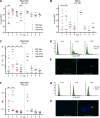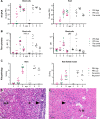Infection with purified Piscine orthoreovirus demonstrates a causal relationship with heart and skeletal muscle inflammation in Atlantic salmon
- PMID: 28841684
- PMCID: PMC5571969
- DOI: 10.1371/journal.pone.0183781
Infection with purified Piscine orthoreovirus demonstrates a causal relationship with heart and skeletal muscle inflammation in Atlantic salmon
Abstract
Viral diseases pose a significant threat to the productivity in aquaculture. Heart- and skeletal muscle inflammation (HSMI) is an emerging disease in Atlantic salmon (Salmo salar) farming. HSMI is associated with Piscine orthoreovirus (PRV) infection, but PRV is ubiquitous in farmed Atlantic salmon and thus present also in apparently healthy individuals. This has brought speculations if additional etiological factors are required, and experiments focusing on the causal relationship between PRV and HSMI are highly warranted. A major bottleneck in PRV research has been the lack of cell lines that allow propagation of the virus. To bypass this, we propagated PRV in salmon, bled the fish at the peak of the infection, and purified virus particles from blood cells. Electron microscopy, western blot and high-throughput sequencing all verified the purity of the viral particles. Purified PRV particles were inoculated into naïve Atlantic salmon. The purified virus replicated in inoculated fish, spread to naïve cohabitants, and induced histopathological changes consistent with HSMI. PRV specific staining was demonstrated in the pathological lesions. A dose-dependent response was observed; a high dose of virus gave earlier peak of the viral load and development of histopathological changes compared to a lower dose, but no difference in the severity of the disease. The experiment demonstrated that PRV can be purified from blood cells, and that PRV is the etiological agent of HSMI in Atlantic salmon.
Conflict of interest statement
Figures











Similar articles
-
Inactivated Piscine orthoreovirus vaccine protects against heart and skeletal muscle inflammation in Atlantic salmon.J Fish Dis. 2018 Sep;41(9):1411-1419. doi: 10.1111/jfd.12835. Epub 2018 Jun 21. J Fish Dis. 2018. PMID: 29926926
-
Piscine Orthoreovirus from Western North America Is Transmissible to Atlantic Salmon and Sockeye Salmon but Fails to Cause Heart and Skeletal Muscle Inflammation.PLoS One. 2016 Jan 5;11(1):e0146229. doi: 10.1371/journal.pone.0146229. eCollection 2016. PLoS One. 2016. PMID: 26730591 Free PMC article.
-
DNA vaccine expressing the non-structural proteins of Piscine orthoreovirus delay the kinetics of PRV infection and induces moderate protection against heart -and skeletal muscle inflammation in Atlantic salmon (Salmo salar).Vaccine. 2018 Nov 29;36(50):7599-7608. doi: 10.1016/j.vaccine.2018.10.094. Epub 2018 Nov 2. Vaccine. 2018. PMID: 30392768
-
Antiviral Responses and Biological Concequences of Piscine orthoreovirus Infection in Salmonid Erythrocytes.Front Immunol. 2019 Jan 16;9:3182. doi: 10.3389/fimmu.2018.03182. eCollection 2018. Front Immunol. 2019. PMID: 30700987 Free PMC article. Review.
-
Sleeping With the Enemy? The Current Knowledge of Piscine Orthoreovirus (PRV) Immune Response Elicited to Counteract Infection.Front Immunol. 2022 Apr 6;13:768621. doi: 10.3389/fimmu.2022.768621. eCollection 2022. Front Immunol. 2022. PMID: 35464421 Free PMC article. Review.
Cited by
-
Detection of Salmonid IgM Specific to the Piscine Orthoreovirus Outer Capsid Spike Protein Sigma 1 Using Lipid-Modified Antigens in a Bead-Based Antibody Detection Assay.Front Immunol. 2019 Sep 6;10:2119. doi: 10.3389/fimmu.2019.02119. eCollection 2019. Front Immunol. 2019. PMID: 31552049 Free PMC article.
-
Identification of a piscine reovirus-related pathogen in proliferative darkening syndrome (PDS) infected brown trout (Salmo trutta fario) using a next-generation technology detection pipeline.PLoS One. 2018 Oct 22;13(10):e0206164. doi: 10.1371/journal.pone.0206164. eCollection 2018. PLoS One. 2018. PMID: 30346982 Free PMC article.
-
High-Load Reovirus Infections Do Not Imply Physiological Impairment in Salmon.Front Physiol. 2019 Mar 13;10:114. doi: 10.3389/fphys.2019.00114. eCollection 2019. Front Physiol. 2019. PMID: 30930782 Free PMC article.
-
Extensive Phylogenetic Analysis of Piscine Orthoreovirus Genomic Sequences Shows the Robustness of Subgenotype Classification.Pathogens. 2021 Jan 7;10(1):41. doi: 10.3390/pathogens10010041. Pathogens. 2021. PMID: 33430212 Free PMC article.
-
PRV-1 Infected Macrophages in Melanized Focal Changes in White Muscle of Atlantic Salmon (Salmo salar) Correlates With a Pro-Inflammatory Environment.Front Immunol. 2021 Apr 29;12:664624. doi: 10.3389/fimmu.2021.664624. eCollection 2021. Front Immunol. 2021. PMID: 33995395 Free PMC article.
References
-
- Walker PJ, Winton JR. Emerging viral diseases of fish and shrimp. Vet Res. 2010;41(6):51 doi: 10.1051/vetres/2010022 - DOI - PMC - PubMed
-
- Kongtorp RT, Taksdal T, Lyngøy A. Pathology of heart and skeletal muscle inflammation (HSMI) in farmed Atlantic salmon Salmo salar. Dis Aquat Organ. 2004;59(3):217–24. doi: 10.3354/dao059217 - DOI - PubMed
-
- Kongtorp RT, Halse M, Taksdal T, Falk K. Longitudinal study of a natural outbreak of heart and skeletal muscle inflammation in Atlantic salmon, Salmo salar L. J Fish Dis. 2006;29(4):233–44. doi: 10.1111/j.1365-2761.2006.00710.x - DOI - PubMed
-
- Kongtorp RT, Kjerstad A, Taksdal T, Guttvik A, Falk K. Heart and skeletal muscle inflammation in Atlantic salmon, Salmo salar L.: a new infectious disease. J Fish Dis. 2004;27(6):351–8. doi: 10.1111/j.1365-2761.2004.00549.x - DOI - PubMed
-
- Palacios G, Løvoll M, Tengs T, Hornig M, Hutchison S, Hui J, et al. Heart and skeletal muscle inflammation of farmed salmon is associated with infection with a novel reovirus. PLoS One. 2010;5(7):e11487 doi: 10.1371/journal.pone.0011487 - DOI - PMC - PubMed
MeSH terms
LinkOut - more resources
Full Text Sources
Other Literature Sources
Medical

